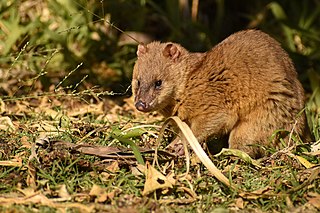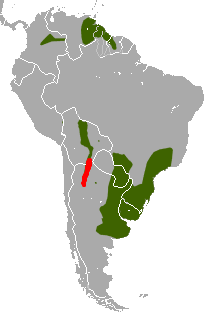
Opossums are members of the marsupial order Didelphimorphia endemic to the Americas. The largest order of marsupials in the Western Hemisphere, it comprises 126 species in 18 genera. Opossums originated in South America and entered North America in the Great American Interchange following the connection of North and South America.
Bibimys is a genus of new world rats. Commonly known as the crimson-nosed rats, there are three species:

The big lutrine opossum, also called little water opossum, thick-tailed opossum and coligrueso, is a long-tailed, otter-like mammal native to grasslands of South America. It generally lives near water and is active at night, dawn or dusk. It eats mice, insects and crabs. Like all opossums, it is a marsupial and carries its young in a pouch.

Lutreolina is a genus of opossum found in South America. Both extant species in this genus are known as lutrine opossums. They have an otter-like body plan and occasionally semiaquatic tendencies, hence the genus name Lutreolina, which is Latin for "otter-like".
Oligoryzomys chacoensis, also known as the Chacoan colilargo or Chacoan pygmy rice rat, is a rodent species from South America. It is found in the Gran Chaco region of southeastern Bolivia, southwestern Brazil, Paraguay, and northeastern Argentina. Its karyotype has 2n = 58 and FNa = 74.

The gray leaf-eared mouse is a rodent species from South America. It is found in Argentina, Bolivia, Brazil and Paraguay; its habitat includes the Gran Chaco.

Akodon spegazzinii, also known as Spegazzini's akodont or Spegazzini's grass mouse, is a rodent in the genus Akodon found in northwestern Argentina. It occurs in grassland and forest at 400 to 3,500 m above sea level. After the species was first named in 1897, several other names were given to various populations now included in A. spegazzinii. They are now all recognized as part of a single, widespread and variable species. Akodon spegazzinii is related to Akodon boliviensis and other members of the A. boliviensis species group. It reproduces year-round. Because it is widely distributed and common, Akodon spegazzinii is listed as "least concern" on the IUCN Red List.
Oligoryzomys destructor, also known as Tschudi's colilargo or the destructive pygmy rice rat, is a species of rodent in the genus Oligoryzomys of family Cricetidae. It is found along the eastern Andes from southern Colombia, through Ecuador, Peru, and Bolivia into northern Argentina. Its karyotype has 2n = 60 and FNa = 76.
The southern climbing mouse is a species of rodent in the family Cricetidae. It is found in Argentina and Bolivia in forested valleys and on slopes on the eastern side of the Andes Mountains.

The Didelphinae are a subfamily of opossums consisting of 15 genera and 123 species. Specimens have been collected throughout the Americas, but are predominant in South and Central America.

Akodon caenosus is a rodent in the genus Akodon found in northwestern Argentina and south-central Bolivia. Since its description in 1918, it has been alternatively classified as a separate species or a subspecies of Akodon lutescens. The species Akodon aliquantulus, described from some very small Argentine specimens in 1999, is now recognized as a synonym of A. caenosus.
Anita's leaf-eared mouse is a species of rodent in the family Cricetidae. It was discovered in Tucumán Province in northwestern Argentina in alder forest of the upper part of the Southern Andean Yungas ecoregion, on the eastern slopes of the Andes. The species is terrestrial and nocturnal, and was named after American zoologist Anita K. Pearson. It appears to be most closely related to the bunchgrass leaf-eared mouse.
Bibimys chacoensis is a species of small rodent of the family Cricetidae living in the north-central part of Southern Cone of South America. The common name of this species is Chaco crimson-nosed rat. It is one of the three species currently recognized under the genus Bibimys.
The ravine hocicudo is a rodent species from South America. It is found in Argentina.

Thylamys pulchellus, known as the Dry Chaco fat-tailed opossum, is a species of opossum in the subfamily Didelphinae. The species is endemic to the Argentine portion of Gran Chaco. The species was also once considered to be a part of the common fat-tailed mouse opossum but is now considered a different species based on morphological and genetic differences.









